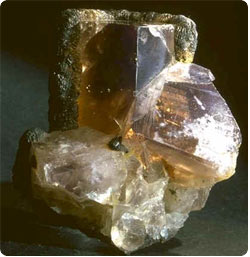The Materials
Fluorspar
 Fluorspar is a crystalline form of calcium fluorite CaF2 which is commonly found deposited in limestone, as at Longstone Edge. Pure fluorspar is colourless but impurities impart a wide variety of colours, the most well-known form being Blue John found nearby at Castleton in Derbyshire.
Fluorspar is a crystalline form of calcium fluorite CaF2 which is commonly found deposited in limestone, as at Longstone Edge. Pure fluorspar is colourless but impurities impart a wide variety of colours, the most well-known form being Blue John found nearby at Castleton in Derbyshire.
Commercially, fluorspar is used to produce aluminium fluoride and hydrofluoric acid. Aluminium fluoride is used in the glass and ceramics industries. Hydrofluoric acid (HF) has a wide variety of industrial applications including electroplating, non-stick surfaces, plastics and uranium manufacture.
Longstone Edge also houses the only UK processor of fluorspar ore - Glebe Mines at Cavendish Mill. We understand that the fluorspar refining process requires a feed stock average concentration of 28% fluorspar, with a minimum fluorspar content of 20%.
By far the largest consumption of HF goes into producing chloroflurocarbons (CFCs) which are used in refrigerants, propellants and synthetic foam and well-known as ozone-depleting chemicals. CFCs were originally being phased-out in favour of hydrofluorocarbons (HFCs) which do not deplete ozone, but HFCs are now known to contribute to the 'greenhouse effect'. This means that demand for fluorspar could decline in the future as these chemicals are phased out.
Limestone
 Limestone is a sedimentary rock composed largely of calcium carbonate, CaCO3. Pure limestone is white or almost white and, like fluorspar, may be coloured by impurities. It may be crystalline, clastic, granular, or massive, depending on the method of formation.
Limestone is a sedimentary rock composed largely of calcium carbonate, CaCO3. Pure limestone is white or almost white and, like fluorspar, may be coloured by impurities. It may be crystalline, clastic, granular, or massive, depending on the method of formation.
As well as its use in architecture, it has an enormous number of industrial uses:
- the manufacture of quicklime (calcium oxide, CaO)and slaked lime (calcium hydroxide, Ca(OH)2)
- cement and mortar
- pulverized limestone is used as a soil conditioner to neutralize acid soil conditions
- crushed for use as aggregate - the solid base for many roads
Longstone Edge consists of limestone deposits from the carboniferous period, which is a very low grade, friable material and, as such, its primary use is to be crushed as aggregate.

